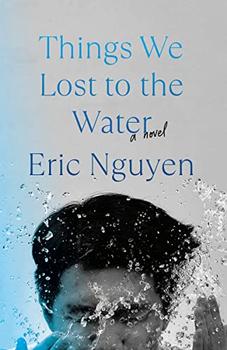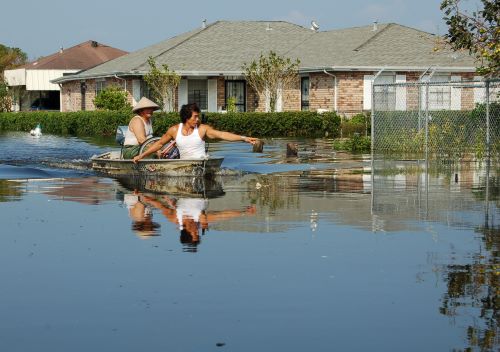Summary | Excerpt | Reviews | Beyond the Book | Read-Alikes | Genres & Themes | Author Bio

Critics' Opinion:
Readers' Opinion:
First Published:
May 2021, 304 pages
Paperback:
Apr 2022, 304 pages
 Book Reviewed by:
Book Reviewed by:
Lisa Butts
Buy This Book
This article relates to Things We Lost to the Water
 When the Vietnamese family depicted in Things We Lost to the Water arrives in New Orleans, they move into an apartment building called Versailles located in the eastern part of the city. The setting is based on the real-life Versailles Arms public housing project in the neighborhood of Village de L'Est, which attracted a large Vietnamese population beginning in 1975 after the fall of Saigon. Many residents were brought to the region via refugee programs run by Catholic charity organizations. The neighborhood's Mary Queen of Vietnam Church, opened in 1985, is the largest Vietnamese American Catholic church in the United States. (A fictionalized version called Our Lady of Saigon appears in the novel.) In research conducted prior to Hurricane Katrina, 80 percent of the Vietnamese population in Village de L'Est identified as Catholic.
When the Vietnamese family depicted in Things We Lost to the Water arrives in New Orleans, they move into an apartment building called Versailles located in the eastern part of the city. The setting is based on the real-life Versailles Arms public housing project in the neighborhood of Village de L'Est, which attracted a large Vietnamese population beginning in 1975 after the fall of Saigon. Many residents were brought to the region via refugee programs run by Catholic charity organizations. The neighborhood's Mary Queen of Vietnam Church, opened in 1985, is the largest Vietnamese American Catholic church in the United States. (A fictionalized version called Our Lady of Saigon appears in the novel.) In research conducted prior to Hurricane Katrina, 80 percent of the Vietnamese population in Village de L'Est identified as Catholic.
When Katrina hit New Orleans in August 2005, flooding Village de L'Est, Mary Queen of Vietnam played a pivotal role in ensuring the safety and recovery of the neighborhood's population. With little help coming in from the federal government in the immediate aftermath of the storm, Father Viên Thế Nguyên organized a group of volunteers to maintain contact with residents who had relocated and spearheaded initial rebuilding efforts. It is believed that the priest's work was largely responsible for the return of the Vietnamese population to the area after the flooding.
The residents of Versailles who stayed in the city during the storm were evacuated to the New Orleans Convention Center, where the conditions were abysmal. They were permitted to return to the apartment complex six weeks later to assess the situation, and rather than leave again as authorities ordered, they stayed and began to clean up, returning to Mary Queen of Vietnam each night to sleep on the floor. The church organized food and clothing drives for those in need. In the first week of November, Father Viên began holding mass again. He reached out to Black churches in the neighborhood (the population of Village de L'Est is about 45 percent Black and 45 percent Asian, according to a 2016 census community survey) and invited their parishioners to attend. With seating for about 800, the first post-Katrina mass at Mary Queen of Vietnam was completely full. One Black community leader explained the significance of Father Viên's work: "After a catastrophe, groups can become more insular, more defensive about protecting their community and businesses. But the Vietnamese folks did just the opposite."
Residents and the church also came together to create the Mary Queen of Vietnam Community Development Corporation in 2006, which worked with local businesses to secure loans and government funding for rebuilding and even expansion. In February 2006, Mayor Ray Nagin announced plans to open a landfill for storm debris less than two miles from Versailles. Angry that the mayor was making this unilateral decision without proper environmental oversight, residents staged a protest at the proposed site that led Mayor Nagin to shelve the idea. This and other events involving the Vietnamese community of Versailles are captured in S. Leo Chiang's documentary film A Village Called Versailles.
The Versailles housing project was torn down in 2016, but the church and the development corporation are still vibrantly active in the community. Some of the latter's current projects include sponsoring a farmers' co-op and community health center and advocating for fishermen whose livelihoods are threatened by the effects of climate change.
Residents of Versailles return to the neighborhood after Hurricane Katrina in 2005. From the documentary film A Village Called Versailles by S. Leo Chiang. Photo credit: Mary Queen of Vietnam Church
Filed under People, Eras & Events
![]() This "beyond the book article" relates to Things We Lost to the Water. It originally ran in June 2021 and has been updated for the
April 2022 paperback edition.
Go to magazine.
This "beyond the book article" relates to Things We Lost to the Water. It originally ran in June 2021 and has been updated for the
April 2022 paperback edition.
Go to magazine.





The House on Biscayne Bay
by Chanel Cleeton
As death stalks a gothic mansion in Miami, the lives of two women intertwine as the past and present collide.

The Flower Sisters
by Michelle Collins Anderson
From the new Fannie Flagg of the Ozarks, a richly-woven story of family, forgiveness, and reinvention.

The Funeral Cryer by Wenyan Lu
Debut novelist Wenyan Lu brings us this witty yet profound story about one woman's midlife reawakening in contemporary rural China.
Your guide toexceptional books
BookBrowse seeks out and recommends the best in contemporary fiction and nonfiction—books that not only engage and entertain but also deepen our understanding of ourselves and the world around us.